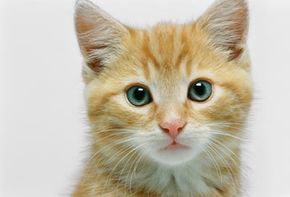Also known as "tactile hairs" or vibrissae, whiskers are the long, thick, flexible hairs on a cat's face. These hairs are located in horizontal rows on the whisker pad, the puffy area between the top corners of your cat's mouth and the outer edges of his nose. Whiskers, like hair and nails, do fall out and are replaced. But whiskers are different from the cat's body hair in a few ways:
- Whiskers should never be cut or trimmed (we'll discuss why later).
- Whiskers are two to three times thicker than the cat's hair.
- Whiskers are rooted very deep in the cat's face, in an area rich in nerves and blood vessels.
In addition to having the long tactile hairs on their cheeks, cats also have shorter ones above their eyebrows, on their chin and on the back of their front legs. Since we are most familiar with facial whiskers, let's look at what they are good for:
Advertisement
- Navigation
- Mood indication
- Measuring an opening
Whiskers help the cat feel his way around. Whiskers are so sensitive that they can detect the slightest directional change in a breeze. At night, for example, this helps a cat slink its way through a room and not bump into anything. How? The air currents in the room change depending on where pieces of furniture are located. As the cat walks through the room and approaches the couch, he'll know which direction to turn based on the change in air current around the couch.
In addition to having sensory properties, a cat's whiskers are also a good indicator of his mood. When a cat is angry or feels defensive, the whiskers will be pulled back. Otherwise, when the cat is happy, curious or content, the whiskers will be more relaxed and pushed forward.
But the whisker's primary use is to help a cat judge whether or not he'll fit through an opening. A cat's whiskers are roughly as wide as his body -- sort of a natural ruler. The whisker tips are sensitive to pressure. You'll probably see a cat stick his head in and out of an opening before he puts his body in. He's judging the width of the opening, and is determining if he can fit into it. An interesting note: cats don't have a true collar bone, like humans. This allows them to turn and twist their way through very narrow openings.
Advertisement

